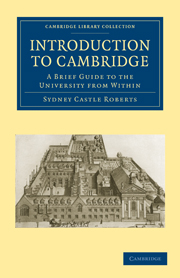I - PAST AND PRESENT
Published online by Cambridge University Press: 10 November 2010
Summary
The official answer to the question “What is the University of Cambridge?” is at once concise and comprehensive. It is “a corporation which, in addition to the usual powers of corporations, such as the ownership of property, possesses the rights of exercising disciplinary authority over its members, returning two representatives to Parliament, and conferring degrees”.
Behind this definition lie some 700 years of history. In the twelfth century the word universitas signified simply an organised body of men, a corporation. Later it was applied especially to a universitas scholarium, a corporation of scholars organised under the direction of “Masters”.
The exact date of the first formation of such a body of scholars in Cambridge is uncertain. Early in the twelfth century the canons of St Giles moved from under the castle walls to a priory at Barnwell; a little later was founded the nunnery of St Rhadegund, which afterwards was converted into Jesus College; on the site of St John's College stood a hospital of Augustinian canons; but it is not until the beginning of the next century that we have definite evidence of the existence of bodies of students in Cambridge. In 1209 there was an upheaval in the University of Oxford which led to a migration of a .considerable number of scholars to Cambridge; and while it is clear that Oxford may claim seniority of foundation, it may well be argued that there would have been no migration to Cambridge if there had not been schools already in existence on the banks of the Cam.
- Type
- Chapter
- Information
- Introduction to CambridgeA Brief Guide to the University from Within, pp. 1 - 28Publisher: Cambridge University PressPrint publication year: 2009First published in: 1934



